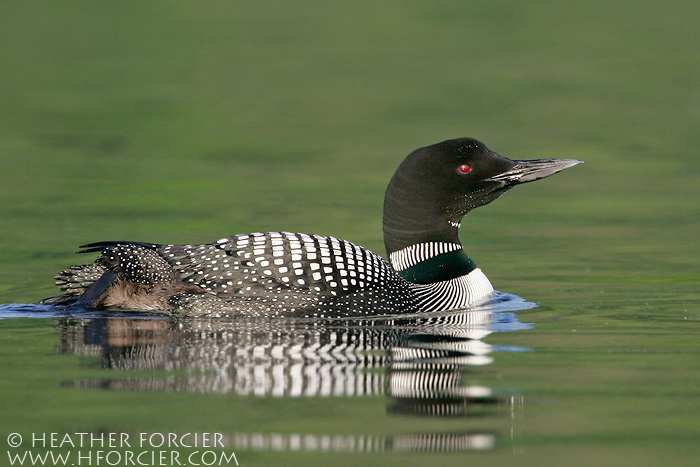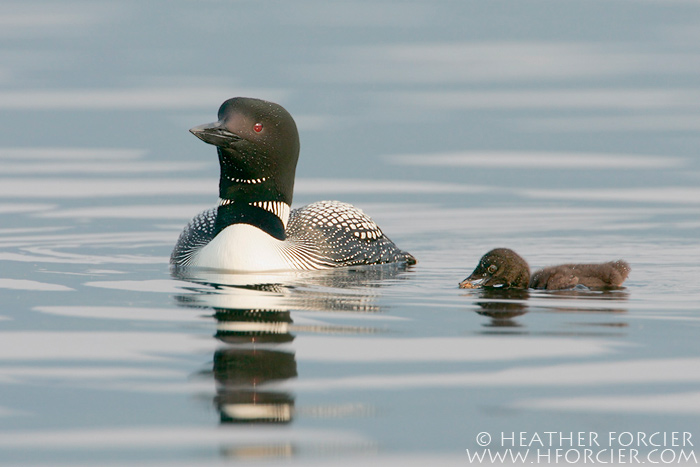 |
WHILE WATCHING LOONS
Text and images copyright Heather Forcier
In Collaboration with Susie Burbidge with the Loon Preservation Committee (LPC)
There is something enchanting about the Common Loon. Typically found in more reclusive habitats, it’s a bird less likely to be seen often. My first memory of a loon was quite some time ago, while camping on a Northwood’s pond; awaking to an ethereal call hanging in the thick morning mist. I couldn’t see the bird that was sending chills through my entire being but I will never forget that morning; how I felt like I was completely part of the nature that surrounded me.
 |
Common Loon, body is well above the surface (a distressed bird may lower its body close to the water) |
Loons are an icon for Vermont as well as several other northern states. Recreational activities like boating, fishing, camping, and nature hikes may bring you near one of these birds. Usually limited to one nesting pair per smaller pond, there could actually be two birds in the area. Nesting may begin late May (peak nest initiation in Vermont and New Hampshire regions is about the first week of June) and chicks may hatch 27-28 days later.
Human presence can have a tremendous influence on these birds. As a photographer I was extremely fortunate to initially be brought to sites where loons were nesting by loon experts. I merely had to focus on light angles and photographing the birds while I knew the care of the birds and our proximity to them was being managed by people much more knowledgeable than I.
 |
Common Loon adult with chick, feeding on a meal just provided by its parent |
It is natural to want to get a closer look at these magnificent birds, whether simply out fishing or birding, or perhaps pursuing a photograph of one. Often the best approach is to drift and allow the curious bird(s) to come toward you. When trying to close the distance between you and a loon there are warning signs they will present that indicate several levels of discomfort.
SLIGHT ALARM
A bird experiencing slight alarm may sink its body down close against the water in a sort of flat profile or it may stretch its neck in an alert posture, trying to assess a potential threatening situation. It may also raise the feathers on its head, creating a “raised brow” look or also a “squared-off” appearance. There can also be a tremolo vocalization, indicating alarm, which sounds a bit like laughter.
While this is only slight alarm this is all a sign to stop any approach and allow the bird to resume normal activities such as foraging, preening, feeding chicks, etc. Although this behavior may not be a result of your presence, but rather a potential threat/predator in the area, it is important not to crowd the bird and cause it further distress as it deals with other factors in its environment.
SEVERE ALARM
The biggest concern about approaching loons is causing potential harm to its family, whether simply eggs or chicks. If a nesting loon lowers its body and head while on a nest it is looking to potentially escape to the water from fear of threat. While these birds may sometimes choose to leave the nest at various times for routine activities, pressuring them off the nest at other times can leave the eggs exposed to predators, or cooling or overheating depending on current temperatures which could kill the embryo. Some loons may even expend effort incubating dead eggs afterwards so it can be difficult to understand what impact we have actually had.
If a nesting loon displays this behavior it is clear it needs more space and you should immediately increase the distance between you and the bird.
Another extremely vulnerable loon is one (or a pair) in the water with young. If the adults vocalize at all this may indicate they feel threatened; if they feel they are being pursued they may swim too quickly for the young to keep up or they may dive, leaving the young alone and exposed to natural predators. Again, behavior like this means the birds need more distance between you and them to feel more at ease and they should be afforded it as quickly as possible to safeguard the young.
When an adult feels extremely threatened it may rear up in the water with its wings outstretched and paddle its feet quickly in the water. It appears that the loon is “dancing” on the water, but this display is a sign that the bird feels extremely threatened. This is very different from a wingflap which is often associated with preening and bathing.
 |
A Common Loon wingflap (above) produces very little splashing, as opposed to its "dancing" display when threatened |
If you are seeking a view of these birds try areas that already have regular boat traffic, as the birds may be more habituated to human presence. Be sure to bring binoculars and be on the lookout for signs that your presence may be disturbing them. In addition to the behavioral signs, any vocalizations may also indicate alarm. The LPC generally recommends that people stay at least 150 ft. from loons. In the event of severe alarm by the bird(s), especially ones tending to eggs or chicks, please increase the distance between you and them quickly and wait to see if the bird(s) settle down. In reality, if they don’t perceive you as a threat it’s possible they will come closer to your boat providing you with an incredible opportunity to see them a bit closer on their own terms.
For more information on loons you can visit the LPC website; for a PDF with additional details on loon behavior visit this page on their website.
| Text and images on this site are copyright Heather Forcier, all rights reserved. No downloading, hotlinking, or other usage allowed without express written permission. Images contain embedded digital watermarks. |